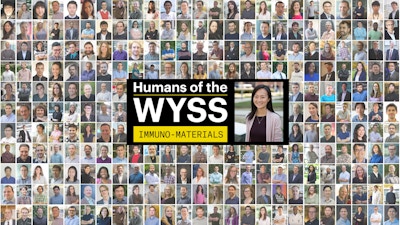
The Humans of the Wyss series features members of the Wyss community discussing how they think about their work, the influences that help shape them as scientists, and their collaborations at the Wyss Institute and beyond.
In this installment of our Immuno-Materials Edition, we talk to Aileen Li, Ph.D., a graduate student in David Mooney’s lab at the Harvard John A. Paulson School of Engineering and Applied Sciences. Aileen talks about her work on an injectable biomaterial scaffold-based vaccine and how she envisions her research impacting the world.
What drives you?
I’m driven by a desire to learn new things, a curiosity to understand how things work and a mission to improve human health. I think that Immuno-Materials is very exciting because it harnesses the power of both engineering and immunology and holds a lot of promise to improve patient lives.
You’re working on an injectable biomaterial scaffold-based vaccine, tell us more.
Biomaterials cancer vaccines that educate one’s own immune system to fight against cancer have tremendous potential. The WDVax developed at the Wyss is currently under a phase I trial in late stage melanoma patients at the Dana-Farber Cancer Institute. Building on this concept, we developed an injectable second-generation vaccine that simplifies the assembly and administration from the first generation WDVax. With this new vaccine platform, we are actively exploring applications ranging from cancer and infectious disease to immune-contraception.
Immuno-Materials is very exciting because it harnesses the power of both engineering and immunology and holds a lot of promise to improve patient lives.
Share with us some of the challenges you’re facing.
Despite the tremendous progress in cancer immunotherapy and immunoengineering, many challenges still remain. For instance, because cancer is a multifaceted disease, how do we design smart technologies to simultaneously solve multiple functional challenges? How do we better predict how a therapy will behave in individual patients? It definitely feels like there are more questions than there are clear answers, which is exactly why research is so exciting to me.
So, what do you see as the next steps for the injectable vaccine?
We are continuing to generate compelling pre-clinical data with the goal of evaluating these vaccines in patients. We would like to see how these vaccines impact patients, and the information we learn from clinical trials would be extremely valuable for us to continue developing future generations of Immuno-Materials technologies.
